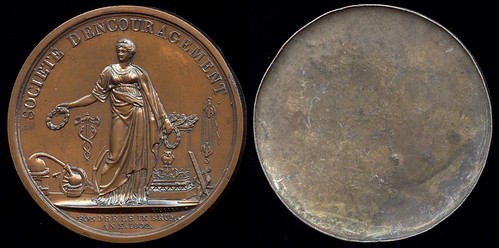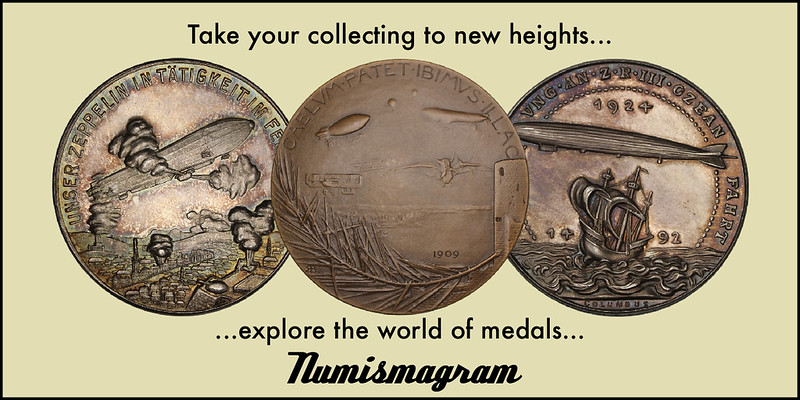
PREV ARTICLE
NEXT ARTICLE
FULL ISSUE
PREV FULL ISSUE
VOCABULARY TERM: CLICHÉDick Johnson submitted this entry from his Encyclopedia of Coin and Medal Terminology. Thanks. I added the below image. Although it may not meet Dick's strict definition, it does show what these generally look like. -Editor

1802 France - Napoleon - Societe d'Encouragement by Pierre-Joseph Tiolier - A Cliché. of the medal
Cliché One-sided medallic items made by placing two thin blanks between a pair of dies and striking in a press. Originally intended for the artist's cabinet, or for museums, clichés mounted side-by-side exhibit both sides of a medal at a glance. When properly made clichés will exhibit suction or ghosting on the two interface surfaces, often the strongest device or feature of the two sides – as an obverse portrait – will form the greatest ghosting evidence. At first clichés appear the same as uniface medals, in that both have design on one side and are basically blank on the other. However clichés differ from uniface medals in how they are made; clichés always have two thin blanks struck simultaneously, uniface medals are struck with a single blank between two dies, one of which is a jack die or blank die. Keying Clichés. Often when clichés of multiple struck medals are made, they will be "keyed" – to be able to join back together the two blanks exactly to be struck a second or subsequent time (an aid for positioning the two blanks in the medal press for each blow). Blanks are keyed by punching one blank with a letter or figure punch (a hand punch will do, usually at the corners of an imaginary triangle or square) on the interface surface; metal from the opposite blank flows into these punch cavities. This will serve as a key to properly position the mated blanks if they need to be placed in the press again or to identify die alignment. Very thin uniface medals are often called clichés (albeit incorrectly). However, true clichés can always be distinguished by the ghosting – and the possible evidence of the keyed punch mark – on the interface surface. An early example of a cliché is a George III Laudatory Medal of 1770 mentioned in Brown (140). The word is French and is pronounced klee-shay. Reportedly the word was named after the sound the press made in striking the two pieces at once.
Looking for the meaning of a numismatic word, or the description of a term? Try the Newman Numismatic Portal's Numismatic Dictionary at: https://nnp.wustl.edu/library/dictionary Or if you would like a printed copy of the complete Encyclopedia, it is available. There are 1,854 terms, on 678 pages, in The Encyclopedia of Coin and Medal Technology. Even running two a week would require more than 19 years to publish them all. If you would like an advance draft of this vital reference work it may be obtained from the author for your check of $50 sent postpaid. Dick Johnson, 139 Thompson Drive, Torrington, CT 06790. 
Wayne Homren, Editor The Numismatic Bibliomania Society is a non-profit organization promoting numismatic literature. See our web site at coinbooks.org. To submit items for publication in The E-Sylum, write to the Editor at this address: whomren@gmail.com To subscribe go to: https://my.binhost.com/lists/listinfo/esylum All Rights Reserved. NBS Home Page Contact the NBS webmaster 
|